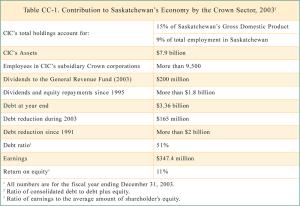
Pragmatism and ideology both influenced the history of Crown corporations in Saskatchewan. Early Crowns concentrated on meeting needs not met by the private sector. The province of Saskatchewan inherited hail insurance and creamery businesses from the North-West Territories; other Crowns soon extended agricultural credit and mined coal. Provincial ownership of telephone systems began in 1908 through the Department of Railway, Telephones and Telegraphs. Involvement with electrical service dates from the 1928 creation of the Saskatchewan Power Commission; municipal and private systems also continued. Following its election in 1944, T.C. Douglas' Co-operative Commonwealth Federation (CCF) government greatly expanded the role of Crown corporations: the Crown Corporations Act of 1945 and new structures followed; ministers chaired advisory boards, while Cabinet retained final responsibility. To increase coordination and planning for the Crowns, the Economic Advisory and Planning Board began in 1946, chaired by British economist George W. Cadbury. The Government Finance Office (GFO) began in 1947 as a holding company and coordinator of Crown operations; it also reinvested profits and paid monies into provincial coffers. To monitor matters, the CCF established the Crown Corporations Committee.
Motivated by socialist ideology, the CCF created numerous new Crowns. Joe Phelps, Minister of the new Department of Natural Resources and Industrial Development, led the charge into public ownership. Saskatchewan Government Insurance Office (SGIO, later SGI) began in 1944. New Crowns in 1945 included Saskatchewan Wool Products, Saskatchewan Leather Products, and Saskatchewan Clay Products. Expropriation following a labour dispute added the Prince Albert Box Factory. Some Crowns proved popular and successful, while others met resistance: for example, many residents opposed government production of woollens, shoes, bricks, and boxes. Success greeted the 1946 acquisition of a sodium sulphate plant at Chaplin, the creation of Saskatchewan Transportation Company (STC), and the Swift Current horse plant, which gathered unwanted horses for slaughter. Provincial involvement with telephone and electrical services also expanded under the CCF: Saskatchewan Government Telephones, later renamed SaskTel, was given responsibility for telephone service in 1947. Saskatchewan Power Corporation (SPC) began in 1949; rural electrification followed in southern Saskatchewan, where SPC soon also distributed natural gas. The Industrial Development Fund and Saskatchewan Economic Development Corporation (SEDCO) encouraged private investment by 1963; one notable success involved aiding IPSCO to locate in Saskatchewan.
In northern Saskatchewan, the CCF used Crown corporations to take over industry and control resources. Saskatchewan Government Airways, later renamed SaskAir, began in 1947 with the purchase of a private company; rapid expansion followed, although efforts to develop a monopoly over northern commercial flying failed. A new Crown, Saskatchewan Fur Marketing Services, raised strong resistance from northern trappers, who opposed compulsory marketing of furs to the Crown; faced with increasing opposition, the compulsory fur program ended in 1955. Saskatchewan Lake and Forest Products Corporation and its divisions, Saskatchewan Forest Products and the Fish Board, operated sawmills, lumberyards, and fish plants; following controversial losses for the Fish Board, a new Crown, Saskatchewan Fish Marketing Services, processed fish. In another effort to displace capitalist enterprise, the CCF retailed goods through Government Trading Services, until stores were transferred to Northern Co-operative Trading Services.
Following the 1964 election of Ross Thatcher's Liberals, free-enterprise ideology dominated and the influence of Crown corporations declined. Thatcher eliminated government monopolies in insurance, timber, and natural gas, and sold SaskAir and the brick plant. Seeing a role for Crowns, the Liberals continued the most popular corporations. A major expansion of government enterprise followed the 1971 election victory of Allan Blakeney and the New Democratic Party (NDP). Ideology again determined policies. The Saskatchewan Mining Development Corporation (SMDC) brought government into uranium mining. Controversially, the NDP added the pulp mill at Prince Albert to the Crown group and cancelled plans for a second pulp mill. SaskOil began after private companies slowed exploration to protest increased royalties. Beginning in 1975, the Potash Corporation of Saskatchewan assumed about one-half of Saskatchewan's potash production. A new Crown Corporation Act in 1978 replaced the GFO with the Crown Investments Corporation (CIC), whose assets totalled about $5 billion by 1981.
A reduction in the role of Crown corporations followed the election of Grant Devine and the Conservatives in 1982. Sales of SaskOil, the pulp mill, the Potash Corporation, and SMDC took place. New Crowns included the Saskatchewan Water Corporation; and SaskEnergy came from a 1988 split of SaskPower. After the return of the NDP in 1991, Premier Roy Romanow adopted a moderate course in relation to Crown corporations. In addition to various smaller Crowns, the stalwart SaskPower, SaskEnergy, SaskTel, STC, and SGI continued. Privatization of the Crowns became a key issue in the 2003 provincial election, and the narrow victory of the NDP indicated the continued support for public ownership among the Saskatchewan electorate.
David M. Quiring